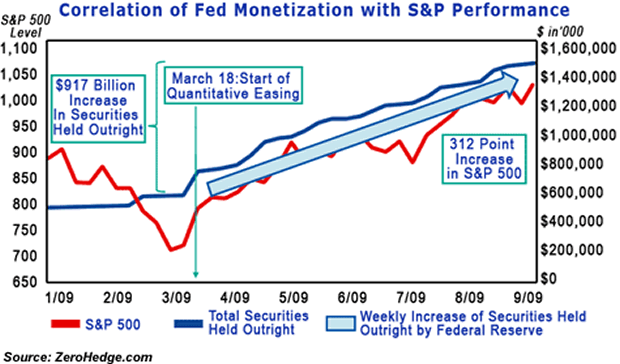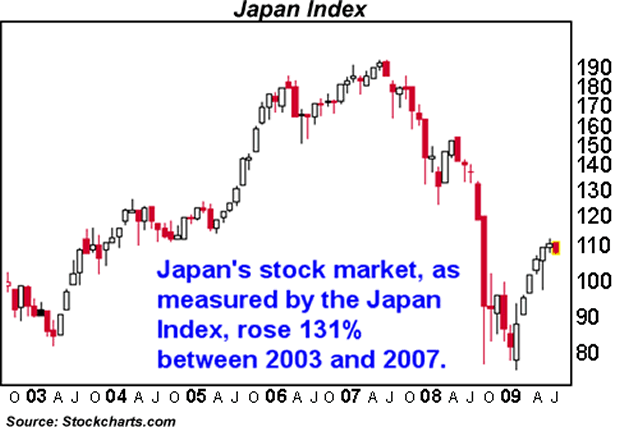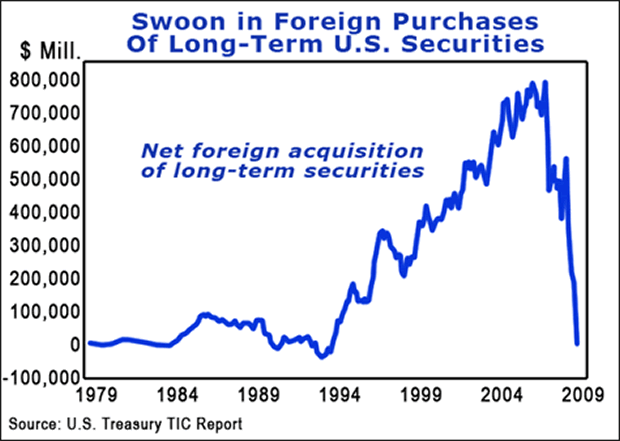Stock Markets Could Soar by Another 50%
Stock-Markets / US Stock Markets Sep 18, 2009 - 08:28 AM GMTBy: Sean_Brodrick
 Many smart people say the markets are headed for another big leg down soon. And maybe they’re right. But traders and investors should always examine opposing views. Today, I want to make the case for stocks going MUCH higher from here. That doesn’t mean I’m bullish on the broad economy — far from it. But stocks could rally — perhaps as much as another 50 PERCENT — riding on a rising flood of government money.
Many smart people say the markets are headed for another big leg down soon. And maybe they’re right. But traders and investors should always examine opposing views. Today, I want to make the case for stocks going MUCH higher from here. That doesn’t mean I’m bullish on the broad economy — far from it. But stocks could rally — perhaps as much as another 50 PERCENT — riding on a rising flood of government money.
And it could go on for quite some time … into next year and maybe beyond.
The government knows what it is doing — reinflating the financial bubble. And it’s doing it for the simple reason that the shadowy power players in Washington and on Wall Street think they have no choice.
Their power is all that matters to them, and they’ll do anything to preserve it — even reinflate a bubble that could be twice as dangerous to America’s economic system next time around.
As the saying goes, “sow the thunder, reap the lightning.” This game could end very badly. When it does, I think you’ll want to own physical gold and silver.
But while the reinflation game is going on, you’ll want to own stocks, bonds — anything that can ride the government bubble.
The good news is there are investments that can rise in both the short-term and the long-term. I’ll have more on that in a bit.
Also importantly, while stocks could rise another 50 percent, the rally could also end today, if we get a big enough external event that rattles the markets hard enough. That’s another good reason to consider “safety” investments.
First, let’s look at some charts and facts …
Here’s a chart I picked up from ZeroHedge.com. I’ve altered it for clarity.

The chart shows how the stock market has climbed at the same time that the Federal Reserve has monetized the debt by purchasing U.S. Treasuries and government-backed debt securities.
The fact that both stocks and Fed debt monetization are going up at the same time is no coincidence. As I explained in my video on Tuesday, just in the United States alone, the Fed has purchased $1.24 TRILLION in Treasury and Agency securities. The Fed plans to buy at least another $507 million in debt over the next couple months.
At the same time, the Fed is holding its key interest rate at essentially zero. Result: Banks are getting to trade nearly worthless securities for cash while at the same time they are able to borrow money at very low rates.
Of course they invest that money in stocks and bonds … and hard assets, like gold and oil and silver and copper.
The government says that it will stop monetizing the debt … and maybe it will. On the other hand, consider that we’re heading into an election year. I think the government has a strong incentive to keep pushing liquidity into the market, if not through debt monetization then through some other scheme, and the government will probably keep doing it at least through the 2010 election.
Why shouldn’t they? They aren’t thinking about consequences. If they were, they wouldn’t be doing what they’re doing now. It’s not like voters are holding them accountable.
Meanwhile, there is $3.5 trillion sitting in U.S. money market funds, according to recent data from the Investment Company Institute. That’s down from a March peak of $3.9 trillion, but it is still HUGE.
Fund managers and individual investors are sitting on that cash, nervously watching stocks go higher. Will they buy in? Of course they will!
As that money gets put to work, stocks, bonds and precious metals will probably go even higher.
How High Can Stocks Go? Pretty Damned High!
Take a look at this chart I made on Stockcharts.com. It’s a monthly chart of the S&P 500, showing how that leading index rallied and rallied hard each time its 5-month moving average crossed above its 15-month moving average. I’ve marked each cross of these moving averages with blue circles.

- In 1995, the 5-15 moving average cross led to a 211 percent rally over the next five years! That was the beginning of the dot-com bubble.
- In 2003, the 5-15 moving average cross led to a 56 percent rally over five years. And you remember 2003, don’t you? That’s when Alan Greenspan kept interest rates lower than low for a long time. All that easy money had to go somewhere, and it went into the market.
- Now, here we are in 2009. Just like in 2003, there’s plenty of easy money around for banks and big investors. And see what’s happening with the moving averages again? The 5-month is about to cross over the 15-month MA. We could be in for a big move … and it could last for a while.
To be sure, there are important differences. But some differences actually make this rally scenario more likely.
The Dollar as the New Carry Trade
The “carry trade” was a period of about five years, from 2003 to 2007, when investors borrowed low-yielding yen (Japanese interest rates never went above 0.5 percent during that time frame) and used the money to buy just about any other currency with a higher yield as well as higher-yielding bonds, commodities, crude oil and even stocks.
By 2007, it was estimated that $1 trillion was wrapped up in the carry trade.
Why did Japan keep interest rates low for so long? Indeed, their low-interest rate policy started in 1995. Japan’s leaders did that because they were trying to prop up zombie banks.
The banks were kneecapped by the collapse of a credit bubble, which led to the cratering of both Japan’s stock market and its housing market.
Gee, do zombie banks, a stock market collapse and housing bubble sound familiar? But apart from a broad economic slump called the “Lost Decade,” some parts of this story didn’t turn out badly for Japan. Take a peek at how the Japanese stock market did between 2003 and 2007 …

Again, there are important differences between Japan then and the United States now. But I’m hearing reports that more big institutions are borrowing money in U.S. dollars and buying other, higher-yielding currencies.
And that’s because, during the past three weeks, borrowing costs in dollars fell below those of yen and Swiss francs for an extended period for the first time since 1994.
Here are a couple of questions for you:
- When you fund in one currency to buy a borrowed currency, what happens to the funding currency — in this case, the dollar?
- Since hard assets (and U.S. stocks) are priced in dollars, what should happen to the price of those assets?
If your answers are “the currency usually goes down in value” and “the assets should go up in price,” go to the head of the class.
But if you think that this ISN’T being planned by our leaders, then it’s the dunce cap for you. Of course this is all according to plan! The Wizards of Wall Street are making your money cheaper on purpose.
The enormous debts run up under Bush and being extended by Obama have to be paid off with something. It’s a lot easier to pay them off if those debts get cheaper along with the value of the dollar. And I’m sure the folks in Washington are thinking, “hey, maybe a cheaper dollar will pump up American exports and jumpstart much-needed job creation!”
So, those furrowed brow-types in Washington and on Wall Street have found a way to reboot the stock market and create more jobs! We should be giving them a round of applause, right?
Well, hold your applause just a minute …
Here’s How Things Can Go Seriously, Terribly, Horribly Wrong
Stocks are rallying even though the broad economy, especially employment, is lagging badly. Unless and until the real economy improves, you can have a market that is stretched far above its fair-market value. That means it will probably be prone to corrections sharp enough to make your head spin.
But that’s not the big problem.
The big problem comes if America careens into a currency crisis. And I think that potential is out there for the U.S. dollar unless something really fundamental changes.
That’s because the insane clown posse in Washington is adding to the debt burden of every American at a frightening pace. You can see this apocalypse in motion for yourself at the U.S. National Debt clock: http://www.usdebtclock.org/.
The U.S. deficit for this year alone is $1.8 trillion. All that debt has to be paid back eventually, and paid back with dollars. When you create more of something, you cheapen its value. In a nutshell, that’s one reason why the U.S. dollar is breaking support and heading lower.
A currency crisis could be mild or severe. In a mild currency crisis, we could see the U.S. dollar lose about 25 percent of its value.
As the value of a currency goes down, inflation picks up, because it takes more dollars to buy something. And if inflation gets really bad, Americans of all stripes will feel the pinch.
But some of our biggest trading partners — China, Russia, India, and various “friends” in the Middle East — are already making louder noises about dumping the dollar as the international reserve currency.
And they aren’t just making noises. They’re already taking action, buying gold and other hard assets, and slashing their purchases of long-term U.S. securities.
Take a look at this chart …

You can see how foreign purchases of long-term U.S. securities are plunging. This is a vote of “no confidence” in the dollar by central banks around the world. This won’t go in a straight line, either. But the trend is clear. This is one reason why the Fed has to buy U.S. Treasuries.
The Ponzi scheme of the U.S. government buying its own debt can’t go on forever. Eventually, the U.S. dollar will crumble, and probably U.S.-dollar-denominated debt along with it.
A move away from the dollar by foreign governments won’t be quick. There are trillions of dollars worth of investments that have to be reallocated. But once started, this juggernaut is hard to stop.
The real problem is that if the greenback loses its status as global reserve currency, then the world won’t need the trillions of dollars stashed in foreign central banks. Those can come back on to the market … sending the dollar lower, and potentially causing a currency crash.
And that brings us to a “severe” currency crisis. In a worst-case scenario, you have the Zimbabwe experience. Interestingly, Zimbabwe shows that a rapidly shrinking currency is actually good for stocks, in a manner of speaking. For example, in one three-month period in 2007, Zimbabwe experienced 1,000 percent inflation. At the same time, its stock market went up 600 percent.
I don’t think we’re headed for Zimbabwe-type hyperinflation. But I don’t know how bad the currency devaluation will be, either. So investing can actually cushion the blow of a shrinking currency — something to keep in mind as the boys in Washington run experiments on the dollar that would make Frankenstein shudder.
Investments for the Long and Short Term
Fundamentals don’t matter in the kind of market I’m talking about. If we really are on the cusp of a big bull run, you’ll want momentum stocks and funds.
Also, if the U.S. dollar is grinding lower, you’ll also probably do well with stocks that deal in hard assets, for the simple reason that the value of their reserves will increase as the value of the dollar goes down.
But even the SPY, which tracks the S&P 500, should do well in a weakening dollar scenario. You might want to wait for a pullback, and there will probably be plenty of them.
A better bet would be an index that tracks gold miners (GDX), agriculture stocks (MOO) or materials (XLB). And ETFs that hold physical gold (GLD) and silver (SLV) should also do well.
My Red-Hot Commodity ETFs subscribers are riding this wave, recently banking one round of double-digit percentage gains on the SLV, and another round of hefty gains on the DGP, a fund which aims to track twice the performance of gold. After banking those gains, my subscribers are holding half the original positions for potentially more. Sweet!
Just remember, a market floating on easy money could quickly capsize. It could tumble very quickly and with very little warning — I highly recommend you use protective stops.
Longer-Term Investments
Longer-term, I think we’re headed for a currency crisis, and you’re going to want to own physical gold and silver — American gold and silver eagle gold coins are a great place to start, as well as silver “rounds,” or one-ounce silver coins produced by various mints.
I also think that even in a currency crunch, stocks of miners that are leveraged to the price of gold and silver should still do well, especially foreign-based miners. And other hard assets should also do well longer-term if the dollar sinks.
The power players in Washington and on Wall Street are sowing the thunder. A storm is coming. Sitting still just makes you a target. Get busy, and you can protect yourself and potentially profit handsomely.
Yours for trading profits,
Sean
P.S. Join Me in Toronto …
I’ll be attending and addressing the Toronto Resource Investment Conference in Toronto, Canada on September 26 & 27. It should be a great show — the other speakers include Frank Holmes, Doug Casey, Paul van Eeden, Jon Nadler, Eric Coffin, James Turk and lots more. I hope you attend, and if you do, please stop by my seminars on Saturday and Sunday and say “hello.” I enjoy meeting subscribers and getting your feedback.
To find out more about this conference, point your web browser to: http://tinyurl.com/lbnmag. For free admission, enter promo code SBT9.
This investment news is brought to you by Uncommon Wisdom. Uncommon Wisdom is a free daily investment newsletter from Weiss Research analysts offering the latest investing news and financial insights for the stock market, precious metals, natural resources, Asian and South American markets. From time to time, the authors of Uncommon Wisdom also cover other topics they feel can contribute to making you healthy, wealthy and wise. To view archives or subscribe, visit http://www.uncommonwisdomdaily.com.
Uncommon Wisdom Archive |
© 2005-2022 http://www.MarketOracle.co.uk - The Market Oracle is a FREE Daily Financial Markets Analysis & Forecasting online publication.



